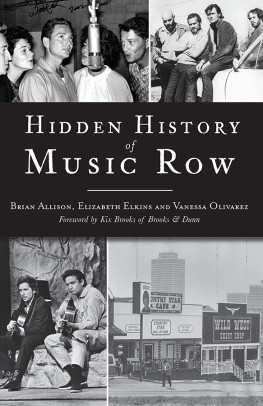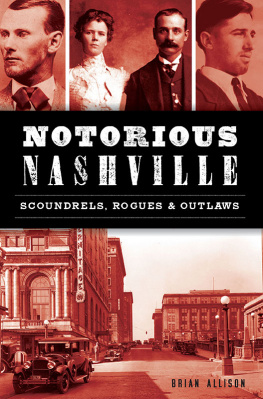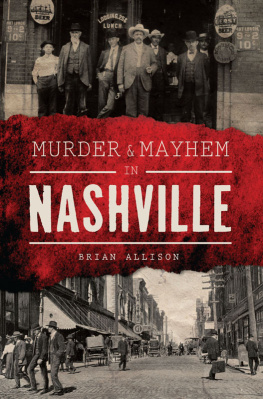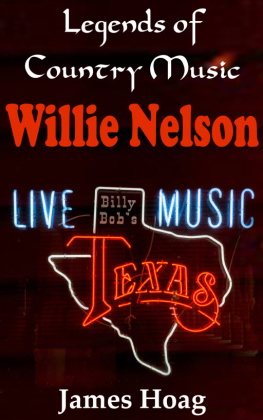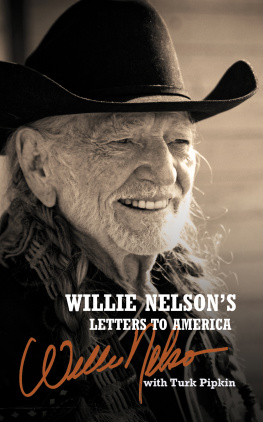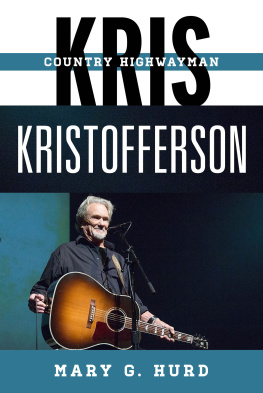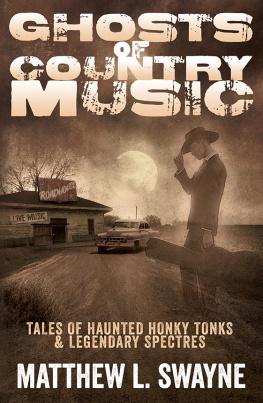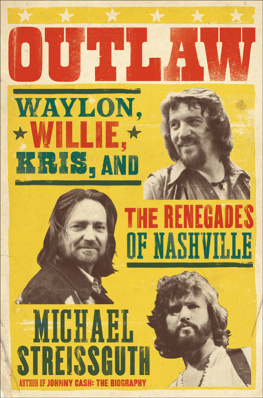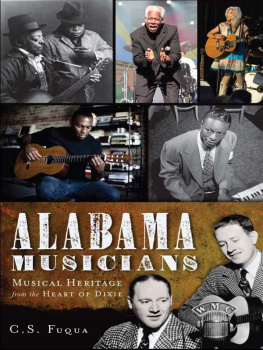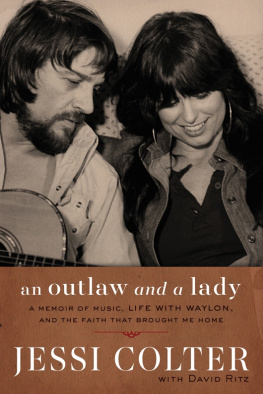


Published by The History Press
Charleston, SC
www.historypress.com
Copyright 2020 by Brian J. Allison, Elizabeth Elkins and Vanessa Olivarez
All rights reserved
First published 2020
E-Book edition 2020
ISBN 978.1.4396.7100.9
Library of Congress Control Number: 2020938432
Print Edition ISBN 978.1.4671.4456.8
Notice: The information in this book is true and complete to the best of our knowledge. It is offered without guarantee on the part of the authors or The History Press. The authors and The History Press disclaim all liability in connection with the use of this book.
All rights reserved. No part of this book may be reproduced or transmitted in any form whatsoever without prior written permission from the publisher except in the case of brief quotations embodied in critical articles and reviews.
CONTENTS
FOREWORD
When I got to Nashville in 1980, I really didnt know what to expect, but most dreamers like me who wander into town to get into the music business imagine tall high-rises full of executives smoking big cigars, ready to make you a star and cheat you out of your money.
My songs werent very good then, even though my friends and family had told me they were. But driving up and down 16th and 17th Avenues playing my music for some of the great ears in the music business was an education that a writer could get literally nowhere else on the planet. I found out there were no high-rises. Instead, there were these little houses like my grandmother used to live in, except the walls were covered in gold records and pictures of the heroes I had grown up withand you could hear guitars and pianos up and down the halls trying to find that special melody to go with the rhyme. And there were the studios where the songs that changed my life had been recordedthey were all right there!
I loved that it was small and unpretentious. Folks were nice enough, but you had to have cred to get to play inside. That was all I wanted. I worked hard and my songs got better. Eventually, 1212 16th Avenue became my home, and legendary producer Don Gant introduced me to a world that songwriters can only hope they will experience if they die and go to heaven.
It doesnt take five minutes to drive down 16th and up 17th Avenue if you dont stop along the way, but for us, that trip could take all night. You wrote all day in one of those little houses, and then you went on the prowl to see who was around. We would gather at different publishers, where writers like Roger Miller, Mickey Newberry, Rafe Van Hoy and Bruce Channel would sit around and play the songs that were written that day. It was competitive, supportive and inspiringit was downright magical actually, and it made you want to write the best you had in you so you could play them one of yours! Those two streets have been a true field of dreams, and many big hitters have made history there.
The stories of the characters who wrote the songs and sang themfrom Willie Nelson and Kris Kristofferson to Hank Williams and Harlan Howardlive in the walls of those little houses alongside the tales of the promoters and record executives who made people rich and famous. Those stories could go on forever. A music fan could spend his life digging into the tales of 16th and 17th Avenues, and this book is certainly one that does a great job of giving you a unique look into a history that so many of us feel is sacred ground and should not be bulldozed in the name of progress. This fun and fabulous place, this sacred ground of creativity, is called Music Row.
Time marches on, and it will never again be like it was in the 60s or 70s or even the 80s, but its mostly still here for now. Magic is still being made, fun is still being had and tears are still being shed when all comes together.
The mission and the responsibility still lives up and down those two avenues, like the last words Guy Clark ever said to me before he passed: Son, go break a heart!
KIX BROOKS
November 18, 2019
Nashville, Tennessee
AUTHORS NOTE
Music Row is as complicated as the musical myths that surround it, both in terms of geography and history. For this book, we define Music Row as the arrowhead-shaped neighborhood stretching from Wedgewood Avenue and Belmont University on the southside, to Broadway and Interstate 40 on the north, with Villa Place as an eastern boundary and Broadway or 18th Avenue as a western one, excluding the intrusion of Vanderbilt University.
It is also important to note that the truth about why and how music is made is often anchored by the memory of those who made it. Stories about its creationand the places it was madeoften change from person to person. We have done our best to hold every source as close to the truth as possible.
CHAPTER 1
YOUR CHEATIN HEART
Timothy Demonbreun and the Street that Got His Name
Elizabeth Elkins
Songwriters come to Nashville because they believe in the power of stories in their greatest form: the myth. These song myths are built around the kind of great stories that haunt youa little bit of the truth, a little bit of a lie and firmly magical. The best country songs arguably create myths of their own: were all still wondering why Billie Joe jumped off the Tallahatchie Bridge, why a man named his boy Sue and why the lights went out in Georgia that night. Part of Nashvilles allure for a songwriter is that one needs to be hereon the streets, in the bars and on the stagesto be a part of its story-making machine. Its a voyeuristic creative life, famously driven by the adage that all you need is three chords and the truth. A few years in, however, and a variation emerges: three chords and a great story.
Locals often remind newcomers that all roads lead down into Nashville. You can come in from the Kentucky hills and cascade south down Interstate 65 past crosswind signs and bourbon makers, dropping hundreds of feet into the citys valley. Or you can come from the west, from the bluffs above the Mississippi, running fast for three hours and slowly descending across the Harpeth River before the skyline juts above the freeway from below. You can speed down Mont Eagle, dodging Civil War ghosts in Murfreesboro before those same skyscrapers stretch before you, their tops only barely visible above the horizon. Or you can drive north through the gentle roll of horse farms in Williamson County and glance at the hill of bones known as Travellers Rest on your right, only to slip further down into land that was once a prehistoric lake bed just as a green sign welcomes you to Music City Metropolitan Nashville Davidson County: Home of the Grand Ole Opry.
You can crowd around a four-top at the Bluebird Caf, eat some barbecue and walk among the former porn shops and pawn shops that now shine like a greener, slower-paced Las Vegas on lower Broadway. You can flip through dusty records at Ernest Tubb Record Shop. You might pull a pillow over your head at the Opryland Hotel at five oclock in the morning when the ghost of Little Jimmy Dickens begins to sound check May the Bird of Paradise Fly Up Your Nose in the atrium below. You can have one heck of a good time among the bachelorette glitz and the rhinestone glamour.
And to get almost anywhere, including Music Row, youll find yourself on a street with a strange, almost malevolent-sounding name: Demonbreun. Its awkwardly hard to pronounce. Dee-mum-BREE-um? De-mum-BRUM? Demon-spawn? (Insider tip: the locals say Duh-mum-BREE-um.) Its the name of the highway exit to reach the long avenues of 16th, 17th, 18th and 19theach block full of record labels and management firms and music publishers, of boys and girls dreaming up gorgeous myths in alleys and Victorian homes in various states of upkeep. Those pickers and grinners, track guys, lyricists, singers and sign-it-on-the-dotted-line power players? Well, theyve only been on the land for sixty-some years. Before that, the man who gave his name to the street that takes a long, slow roll uphill to the Music Row Round-about had a lot going on.
Next page
